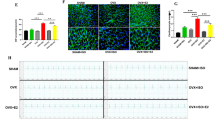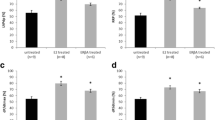Abstract
Estrogen and β2-adrenergic receptors (β2AR) play important roles in the processes that protect the heart. Here, we investigated how ovariectomy influenced the β2AR downstream pathways in the context of catecholaminergic stress. In vivo and in vitro stress models were developed in female Sprague-Dawley (SD) rats by epinephrine (Epi) treatments. The cardiac function was evaluated at in vivo and in vitro levels in terms of contraction, rhythm, and injury. We found that myocardial contractility was not significantly different between Sham and ovariectomized (OVX) group rats in the normal state. However, Epi pretreatment decreased the contractility and increased abnormal rhythms especially in OVX group, which were attributed to lack of estrogen. Inhibition of the β2AR-Gi-PI3K/p38MAPK pathway with ICI118,551, PTX or LY294002 increased contractility and aggravated Epi-induced injury on cardiomyocytes, decreased p38MAPK phosphorylation, and only increased arrhythmia in Sham group. These results indicated that OVX exacerbated cardiac injury and abnormal rhythms through β2AR-Gi-PI3K and β2AR-Gi-p38MAPK pathways, respectively. In normal state, the levels of activated Gi were similar in both groups, but those of cAMP and activated Gs were higher in OVX group. Epi treatment increased activated Gi (especially in Sham group) and activated Gs and cAMP in Sham group but decreased it in OVX group. These results suggested that estrogen increased the Gi activity in normal and stress states and Gs activity in stress state. These results indicated that lack of estrogen impaired the β2AR-Gs/Gi coupling during stress which compromised cardiac contractility and increased abnormal rhythms.





Similar content being viewed by others
Abbreviations
- AC:
-
adenylyl cyclase
- BNP:
-
brain natriuretic peptide
- β1AR:
-
β1-adrenoceptor
- β2AR:
-
β2-adrenoceptor
- Epi:
-
epinephrine
- EF:
-
left ventricular ejection fraction
- Gs:
-
stimulatory G proteins
- Gi:
-
inhibitory G proteins
- ISO:
-
isoprenaline
- LDH:
-
lactic dehydrogenase
- LVIDd:
-
left ventricular internal diameters at End-diastolic dimension
- LVIDs:
-
left ventricular internal diameters at End-systolic dimension
- OVX:
-
ovariectomy
- p38 MAPK:
-
p38 mitogen-activated protein kinase
- PKA:
-
protein kinase A
- PI3K:
-
phosphoinositide 3-kinase
- TCM:
-
Takotsubo cardiomyopathy
- VPB:
-
ventricular premature beat
- VT:
-
ventricular tachycardia
- VF:
-
ventricular fibrillation
- Epac :
-
exchange protein directly activated by cAMP
References
Ai X, Yan J, Carrillo E, Ding W (2016) The stress-response MAP kinase signaling in cardiac arrhythmias. Rev Physiol Biochem Pharmacol 172:77–100. https://doi.org/10.1007/112_2016_8
Anastasaki C, Gutmann DH (2014) Neuronal NF1/RAS regulation of cyclic AMP requires atypical PKC activation. Hum Mol Genet 23(25):6712–6721. https://doi.org/10.1093/hmg/ddu389
Akashi YJ, Nef HM, Lyon AR (2015) Epidemiology and pathophysiology of Takotsubo syndrome. Nat Rev Cardiol 12(7):387–397. https://doi.org/10.1038/nrcardio.2015.39.
Akashi YJ, Nef HM, Mollmann H, Ueyama T (2010) Stress cardiomyopathy. Annu Rev Med 61(1):271–286. https://doi.org/10.1146/annurev.med.041908.191750
Aschar-Sobbi R, Izaddoustdar F, Korogyi AS, Wang Q, Farman GP, Yang FH, Yang W, Dorian D, Simpson JA, Tuomi JM, Jones DL, Nanthakumar K, Cox B, Wehrens XHT, Dorian P, Backx PH (2015) Increased atrial arrhythmia susceptibility induced by intense endurance exercise in mice requires TNF-alpha. Nat Commun 6:6018. https://doi.org/10.1038/ncomms7018.
Chakir K, Daya SK, Aiba T, Tunin RS, Dimaano VL, Abraham TP, Jaques K, Lai EW, Pacak K, Zhu WZ, Xiao R, Tomaselli GF, Kass D (2009) Mechanisms of enhanced beta-adrenergic reserve from cardiac resynchronization therapy. Circulation 119(9):1231–1240. https://doi.org/10.1161/CIRCULATIONAHA.108.774752
Curtis MJ, Hancox JC, Farkas A, Wainwright CL, Stables CL, Saint D, Clements-Jewery H, Lambiase PD, Billman GE, Janse MJ, Pugsley MK, Ng GA, Roden DM, Camm AJ, Walker MJA (2013) The Lambeth conventions (II): guidelines for the study of animal and human ventricular and supraventricular arrhythmias. Pharmacol Ther 139(2):213–248. https://doi.org/10.1016/j.pharmthera.2013.04.008
Chesley A, Lundberg MS, Asai T, Xiao RP, Ohtani S, Lakatta EG, Crow MT (2000) The β2-adrenergic receptor delivers an antiapoptotic signal to cardiac myocytes through Gi-dependent coupling to phosphatidylinositol 3′-kinase. Circ Res 87(12):1172–1179. https://doi.org/10.1161/01.RES.87.12.1172.
Curtis MJ, Walker MJ (1988) Quantification of arrhythmias using scoring systems: an examination of seven scores in an in vivo model of regional myocardial ischemia. Cardiovasc Res 22(9):656–665. https://doi.org/10.1093/cvrese/22.9.656.
Cao X, Zhou C, Chong J, Fu L, Zhang L, Sun D, Hou H, Zhang Y, Li D, Sun H (2015) Estrogen resisted stress-induced cardiomyopathy through increasing the activity of beta (2) AR-G alpha signal pathway in female rats. Int J Cardiol 187:377–386. https://doi.org/10.1016/j.ijcard.2015.02.113
Fujita T, Umemura M, Yokoyama U, Okumura S, Ishikawa Y (2017) The role of Epac in the heart. Cell Mol Life Sci 74(4):591–606. https://doi.org/10.1007/s00018-016-2336-5
Gomes HL, Graceli JB, Goncalves WLS et al (2012) Influence of gender and estrous cycle on plasma and renal catecholamine levels in rats. Can J Physiol Pharmacol 90(1):75–82. https://doi.org/10.1139/y11-102
Garcia M, Mulvagh SL, Merz CNB, Buring JE, Manson JE (2016) Cardiovascular disease in women: clinical perspectives. Circ Res 118(8):1273–1293. https://doi.org/10.1161/CIRCRESAHA.116.307547
Heusch G, Sipido KR (2004) Myocardial hibernation: a double-edged sword. Circ Res 94(8):1005–1007. https://doi.org/10.1161/01.RES.0000128071.90075.e3
Huynh K (2015) Cardiomyopathies: clinical features of patients with Takotsubo syndrome. Nat Rev Cardiol 12(12):684. https://doi.org/10.1038/nrcardio.2015.153
Machuki JO, Zhang HY, Harding SE, Sun H (2017) Molecular pathways of oestrogen receptors and β-adrenergic receptors in cardiac cells: recognition of their similarities, interactions and therapeutic value. Acta Physiol 00:e12978. https://doi.org/10.1111/apha.12978
Kang S, Liu Y, Sun D, Zhou C, Liu A, Xu C, Hao Y, Li D, Yan C, Sun H (2012) Chronic activation of the G protein-coupled receptor 30 with agonist G-1 attenuates heart failure. PLoS One 7(10):e48185. https://doi.org/10.1371/journal.pone.0048185
Lezoualc’h F, Fazal L, Laudette M, Conte C (2016) Cyclic AMP sensor EPAC proteins and their role in cardiovascular function and disease. Circ Res 118(5):881–897. https://doi.org/10.1161/CIRCRESAHA.115.306529
Liu A, Gao L, Kang S, Liu Y, Xu C, Sun H, Li D, Yan C (2012) Testosterone enhances estradiol’s cardioprotection in ovariectomized rats. J Endocrinol 212(1):61–69. https://doi.org/10.1530/JOE-11-0181
Ljungman C, Kahan T, Schioler L et al (2014) Gender differences in antihypertensive drug treatment: results from the Swedish Primary Care Cardiovascular Database (SPCCD). J Am Soc Hypertens 8(12):882–890. https://doi.org/10.1016/j.jash.2014.08.015
Lyon AR, Rees PSC, Prasad S, Poole-Wilson PA, Harding SE (2008) Stress (Takotsubo) cardiomyopathy—a novel pathophysiological hypothesis to explain catecholamine-induced acute myocardial stunning. Nat Clin Pract Cardiovasc Med 5(1):22–29. https://doi.org/10.1038/ncpcardio1066
Liu R, Ramani B, Soto D, De Arcangelis V, Xiang Y (2009) Agonist dose-dependent phosphorylation by protein kinase A and G protein-coupled receptor kinase regulates β2 adrenoceptor coupling to G(i) proteins in cardiomyocytes. J Biol Chem 284(47):32279–32287. https://doi.org/10.1074/jbc.M109.021428
Mikkola TS, Gissler M, Merikukka M, Tuomikoski P, Ylikorkala O (2013) Sex differences in age-related cardiovascular mortality. PLoS One 8(5):e63347. https://doi.org/10.1371/journal.pone.0063347
Jørgensen ME, Hlatky MA, Køber L, Sanders RD, Torp-Pedersen C, Gislason GH, Jensen PF, Andersson C (2015) β-blocker–associated risks in patients with uncomplicated hypertension undergoing noncardiac surgery. JAMA Intern Med 175(12):1923–1931. https://doi.org/10.1001/jamainternmed.2015.5346
Nef HM, Mollmann H, Akashi YJ, Hamm CW (2010) Mechanisms of stress (Takotsubo) cardiomyopathy. Nat Rev Cardiol 7(4):187–193. https://doi.org/10.1038/nrcardio.2010.16
Paur H, Wright PT, Sikkel MB, Tranter MH, Mansfield C, O'Gara P, Stuckey DJ, Nikolaev VO, Diakonov I, Pannell L, Gong H, Sun H, Peters NS, Petrou M, Zheng Z, Gorelik J, Lyon AR, Harding SE (2012) High levels of circulating epinephrine trigger apical cardiodepression in a beta2-adrenergic receptor/Gi-dependent manner: a new model of Takotsubo cardiomyopathy. Circulation 126(6):697–706. https://doi.org/10.1161/CIRCULATIONAHA.112.111591
Rajagopal S, Kim J, Ahn S, Craig S, Lam CM, Gerard NP, Gerard C, Lefkowitz RJ (2010) Beta-arrestin-but not G protein-mediated signaling by the “decoy” receptor CXCR7. Proc Natl Acad Sci U S A 107(2):628–632. https://doi.org/10.1073/pnas.0912852107.
Rau T, Nose M, Remmers U et al Overexpression of wild-type Galpha(i)-2 suppresses beta-adrenergic signaling in cardiac myocytes. FASEB J 17:523–525. https://doi.org/10.1096/fj.02-0660fje
Surinkaew S, Kumphune S, Chattipakorn S, Chattipakorn N (2013) Inhibition of p38 MAPK during ischemia, but not reperfusion, effectively attenuates fatal arrhythmia in ischemia/reperfusion heart. J Cardiovasc Pharmacol 61(2):133–141. https://doi.org/10.1097/FJC.0b013e318279b7b1
Schwartz PJ, Volders PGA (2014) Sudden death by stress: how far under the nerves should we dig to find out why LQT1 patients die? J Am Coll Cardiol 63(8):828–830. https://doi.org/10.1016/j.jacc.2013.09.059
Sun H, Zhou F, Wang Y, Zhang Y, Chang A, Chen Q (2006) Effects of beta-adrenoceptors overexpression on cell survival are mediated by Bax/Bcl-2 pathway in rat cardiac myocytes. Pharmacology 78(2):98–104. https://doi.org/10.1159/000095785
Traynham CJ, Cannavo A, Zhou Y, Vouga A, Woodall BP, Hullmann JE, Ibetti J, Gold JI, Chuprun JK, Gao E, Koch WJ (2015) Differential role of G protein-coupled receptor kinase 5 in physiological versus pathological cardiac hypertrophy. Circ Res 117:1001–1012. https://doi.org/10.1161/CIRCRESAHA.115.306961
Thandroyen FT, Morris AC, Hagler HK, Ziman B, Pai L, Willerson JT, Buja LM (1991) Intracellular calcium transients and arrhythmia in isolated heart cells. Circ Res 69(3):810–819. https://doi.org/10.1161/01.RES.69.3.810
Wang Y, De Arcangelis V, Gao X, Ramani B, Jung Y, Xiang Y (2008) Norepinephrine- and epinephrine-induced distinct beta2-adrenoceptor signaling is dictated by GRK2 phosphorylation in cardiomyocytes. J Biol Chem 283(4):1799–1807. https://doi.org/10.1074/jbc.M705747200
Wu Q, Zhao Z, Sun H, Hao Y, Yan C, Gu S (2008) Oestrogen changed cardiomyocyte contraction and beta-adrenoceptor expression in rat hearts subjected to ischaemia-reperfusion. Exp Physiol 93(9):1034–1043. https://doi.org/10.1113/expphysiol.2007.041939a
Xu C, Liu A, Sun H, Sun Y, Wang G, Gao L, Hao Y, Yan C (2010) β2-Adrenoceptor confers cardioprotection against hypoxia in isolated ventricular myocytes and the effects depend on estrogenic environment. J Recept Signal Transduct 30(4):255–261. https://doi.org/10.3109/10799893.2010.488242.
Yarnell J (2008) Stress at work—an independent risk factor for coronary heart disease? Eur Heart J 29(5):579–580. https://doi.org/10.1093/eurheartj/ehm641
Zhu WZ, Zheng M, Koch WJ, Lefkowitz RJ, Kobilka BK, Xiao RP (2001) Dual modulation of cell survival and cell death by β2-adrenergic signaling in adult mouse cardiac myocytes. Proc Natl Acad Sci U S A 98(4):1607–1612. https://doi.org/10.1073/pnas.98.4.1607
Funding
This work was supported by the National Natural Science Foundation of China (No.81370329, No.81461138036) and the Priority Academic Program Development of Jiangsu Higher Education Institutions (PAPD).
Author information
Authors and Affiliations
Corresponding author
Ethics declarations
Ethical approval
All studies complied with the Animal Ethics Committee of Xuzhou Medical University (permit number: xz11-12540) and with the Guideline for the Care and Use of Laboratory Animals published by the US National Institutes of health (NIH Publication, 8th Edition, 2011).
Competing interests
The authors declare that they have no conflict of interest.
Rights and permissions
About this article
Cite this article
Hou, H., Zhao, Z., Machuki, J.O. et al. Estrogen deficiency compromised the β2AR-Gs/Gi coupling: implications for arrhythmia and cardiac injury. Pflugers Arch - Eur J Physiol 470, 559–570 (2018). https://doi.org/10.1007/s00424-017-2098-4
Received:
Revised:
Accepted:
Published:
Issue Date:
DOI: https://doi.org/10.1007/s00424-017-2098-4




